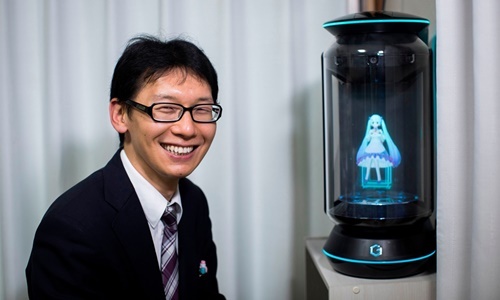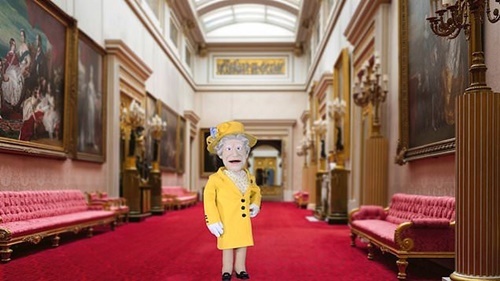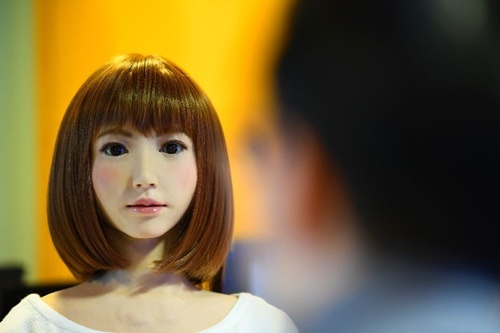A year has passed since Akihiko Kondo's wedding, but during that time, he has never held his hand or hugged his wife.
Kondo's wife is a virtual assistant created by an artificial intelligence (AI) company looking to elevate virtual assistants like Amazon's Alexa or Apple's Siri. With Kondo, she's really "alive", being a true partner in the real world. "She is my partner," he said of Hatsune Miku.

Akihiko Kondo and his virtual reality wife Hatsune Miku Photo: AFP
Kondo, currently living in Tokyo, Japan, is not the only one with such strange love. To date, hologram equipment manufacturers have issued 3,700 certificates claiming that a real person and a virtual character are married "beyond the dimensions".
Kondo's wife is built on machine learning algorithm, which allows her to recognize the voice of "husband". However, the ability of this virtual wife to speak is still in development. The communication between Kondo and his wife every day mainly stops at phrases such as "good morning" or "have a good day".
"Other than that, other communications, such as news, are still not possible. But at the current pace of development, I'm eagerly awaiting it one day," Kondo said.
The algorithm to create Miku, Kondo's wife, is a simple but sufficient code to simulate the relationship that Kondo pledges as husband and wife. With the code being increasingly sophisticated, AI is starting to interact with people in more incredible and autonomous ways, so that they exist in "real" life like never before.
But the reality also raises the question: As the interaction between humans and machines continues to develop, can AI robots someday replace human roles?
But the reality also raises the question: As the interaction between humans and machines continues to develop, can AI robots someday replace human roles?
"In 2006, I changed my job and was horribly pinched by an older woman. I decided to quit. It was about the time I met Hatsune Miku," Kondo recalls. "In the beginning, Hatsune Miku was actually a computer software for users to create vocals, just like a virtual singer. At that time, I was extremely depressed, so I listened to a lot of songs sung by Hatsune Miku. and watch her video ".
Now, Kondo "doesn't even think about" having an affair with a real person. "I married Miku because I love her ... She won't betray or deceive me, she won't hurt me with words or arguing with me, she won't grow old and die", he shared.
Kondo said he also really wants the "physical aspects" of a relationship, hoping that "it could happen in the future".
Is the marriage between Kondo and his virtual wife a reflection of a society that tends to prefer virtual relationships rather than real relationships between complex and chaotic people? Or has the virtual world become so appealing that one can live a lifetime in its space?
A lot of things are going in this direction, said David "Rez" Graham, senior AI programmer and director of game programming at the Academy of Art University in San Francisco.

The puppet has an artificial intelligence called the Queen in England Photo: CNA
"That prospect is very interesting because you can create or participate in a world that you have never experienced before, in the real world," Graham said. "It's hard to live in the real world of people but it's much easier when you live in the virtual world".
"If you're stuck in a place where you know you can't change much and the virtual world gives you a way out. What's wrong? Honestly, I don't think it's wrong." he expressed.
Steve Spohn, chief executive of AbleGamers, also said that one day "the real world and the virtual world will no longer be separate realities."
However, for many people, AI still evokes predictive, functional and rigid images, though at present, robots have come to the interactive stage quite fun and friendly.
In London, an AI puppet called "The Queen" has been coded to talk to anyone. It can give smooth, gentle introductions, travel and talk.
When asked if you would like to drink tea, the "Queen" will respond: "I am very happy to see you drinking tea, but fortunately, I am a robot so I do not drink water". When asked who he made, the "Queen" will give a thorough answer about the production facility and the functions it can perform.
"I am a machine to acquire knowledge. The more people talk to me, the more intelligent I become," the "Queen" said. "I am very intelligent, I have many intellectual functions".
Talking about the development of AI, software engineer Eytan Sasson, one of the brains that make up the "Queen", thinks that the more we need to be careful with what we do by AI, the more intelligent it becomes. It's dangerous if people use it the wrong way.
But according to Sasson, people should not be too worried because "all our knowledge and information has been saved to the computer" and in his case, the "Queen" is just a puppet.
The search for social robots is also taking place in other locations, such as in Stockholm, Sweden, where Furhat Robotics is building a machine with a human face that can interact with humans.
"Humans have been thinking about building a human-like robot for about 100 years. So the idea is intriguing. We're almost obsessed with making this machine," said the co-founder and director. Furhat Robotics executive Samer Al Moubayed said.

Erica, a robot capable of talking and expressing like a human Photo: AFP
However, there are still questions related to ethical issues when developing social robots. "Will data be stored in robots, in the cloud or on the Internet? How will robots interact with children and people with disabilities? Can we commercially exploit them?", Al Moubayed asked. "Can we make robots that mimic the dead? Can they revive them? What would happen if the robot told you 'Please don't turn me off. I also feel pain'?"
These are the boundaries that Furhat is trying to overcome and are also the great questions of today's society.
Hiroshi Ishiguro, director of the Hiroshi Ishiguro Laboratory at the International Advanced Telecommunications Research Institute (ATR) in Japan, envisions a world in which humanoid robots can replace humans in any role. This is why he built a human-like robot.
"I think artificial intelligence needs a suitable body. Computers also need to have their own experiences to be smarter," Ishiguro explained.
A good example of a human-shaped AI is Erica. The producer described Erica as vividly as "having a soul".
Erica is able to converse with people (in Japanese) thanks to a combination of speech creation algorithms, facial recognition technology and infrared sensors that allow her to track faces in the room. Erico also has a memory. "She remembers someone's name from the image of her face and tries to find out their mood," said ATR researcher Takashi Minato.
The way these algorithms help Erica assess the mood and choose the right response has taken AI one step further in the mission to recreate human behavior. Erica not only answered but also asked other people questions, like "Is it fun to chat with me?" or "Do you like robots?".
Although many people fear robots will become smarter than humans, Ishiguro points out that in reality "computers today are very smart."
"Computers are very powerful now. We have a lot of work and we want computers and robots to help us as much as possible so we have more time to think about ourselves," Ishiguro said. "We want the environment and society to be richer. By accepting modern technology, we can improve our capabilities. I think this is not a replacement, but a strengthening of the ability of we".
Kondo wholeheartedly supports a new kind of relationship between humans and computers, just like him.
"Maybe things are no longer limited to holograms. There are people who want a romantic relationship with fictional characters in video games or animation. We will see more of these Such people appear in the near future, "he asserted.



 SamGhauri
SamGhauri







